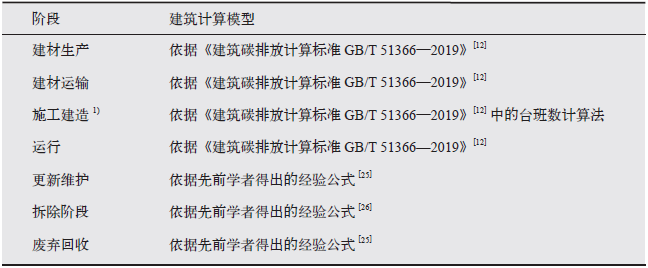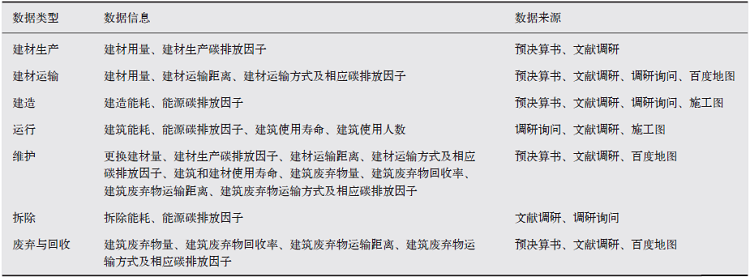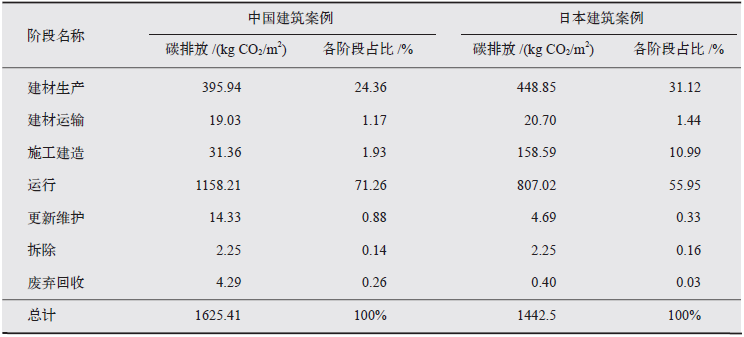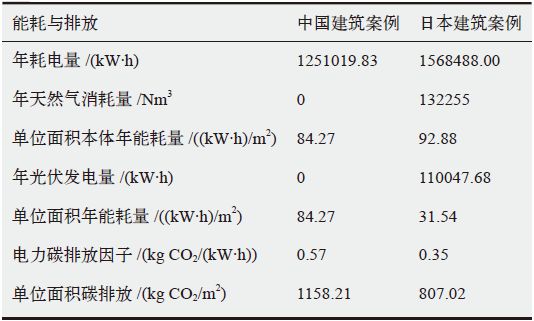气候变化研究进展 ›› 2024, Vol. 20 ›› Issue (2): 220-230.doi: 10.12006/j.issn.1673-1719.2023.195
中日建筑全生命周期碳排放比较
- 1 浙江大学建筑工程学院,杭州 310012
2 浙江大学平衡建筑研究中心,杭州 310063
-
收稿日期:2023-09-11修回日期:2023-12-23出版日期:2024-03-30发布日期:2024-01-15 -
作者简介:罗晓予,女,副教授,xiaoyuluo@zju.edu.cn -
基金资助:浙江省“尖兵”“领雁”研发攻关计划(2023C03173);政府间国际创新合作重点专项(2018YFE0106100)
Comparison of carbon emissions throughout the entire lifecycle of buildings between China and Japan
LUO Xiao-Yu1,2( ), CAO Xing-Yu1, SONG Zhi-Qian1
), CAO Xing-Yu1, SONG Zhi-Qian1
- 1 College of Civil Engineering and Architecture, Zhejiang University, Hangzhou 310012, China
2 Center for Balance Architecture, Zhejiang University, Hangzhou 310063, China
-
Received:2023-09-11Revised:2023-12-23Online:2024-03-30Published:2024-01-15
摘要:
全生命周期的建筑碳减排在日本已有广泛的应用和发展。由于中日建筑全生命周期碳排放统计口径存在差异,为准确开展中日建筑碳排放对比分析带来了难度。文中首先从计算边界、建材统计精度、碳排放因子数量等方面建立了中日同口径的全生命周期碳排放计算模型,并基于此对中日案例建筑的全生命周期碳排放特征开展比较和分析。发现中国案例的建筑全生命周期碳排放略高于日本,其中运行阶段碳排放明显高于日本。此外建筑建材性能对碳排放影响显著,日本建筑利用低碳建材,生产碳排放低,建材使用寿命长,使维护、废弃阶段碳排放均低于中国建筑案例。
引用本文
罗晓予, 曹星煜, 宋志茜. 中日建筑全生命周期碳排放比较[J]. 气候变化研究进展, 2024, 20(2): 220-230.
LUO Xiao-Yu, CAO Xing-Yu, SONG Zhi-Qian. Comparison of carbon emissions throughout the entire lifecycle of buildings between China and Japan[J]. Climate Change Research, 2024, 20(2): 220-230.
 |
表7 中日案例建筑单位面积建材用量与同类建材碳排放因子对比
Table 7 Comparison of building materials consumption per unit area and carbon emission factors of similar building materials in Chinese and Japanese cases
 |
| [1] | 刘志仁. 论“双碳”背景下中国碳排放管理的法治化路径[J]. 法律科学, 2022 (3): 94-104. |
| Liu Z R. On the legalization path of carbon emission management in China under the background of “Dual Carbon”[J]. Legal Science, 2022 (3): 94-104 (in Chinese) | |
| [2] | 张时聪, 王珂, 杨芯岩, 等. 建筑部门碳达峰碳中和排放控制目标研究[J]. 建筑科学, 2021, 37 (8): 189-198. |
| Zhang S C, Wang K, Yang X Y, et al. Research on carbon peak and carbon neutrality emission control objectives in the construction sector[J]. Building Science, 2021, 37 (8): 189-198 (in Chinese) | |
| [3] | 清华大学建筑节能研究中心. 中国建筑节能年度发展研究报告2022[M]. 北京: 中国建筑工业出版社, 2022. |
| Tsinghua University Building Energy Efficiency Research Center. Annual development research report on building energy efficiency in China, 2022[M]. Beijing: China Architecture & Building Press, 2022 (in Chinese) | |
| [4] | 鲁旭旻, 隋杰礼, 韩兆鹏, 等. 基于建筑节能策略差异化对比: 以德国、日本为例[J]. 能源与节能, 2021, 194 (11): 52-56. |
| Lu X M, Sui J L, Han Z P, et al. Differentiated comparison of building energy conservation strategies: taking Germany and Japan as examples[J]. Energy and Energy Conservation, 2021, 194 (11): 52-56 (in Chinese) | |
| [5] | Zhang S F, Ma M D, Li K, et al. Historical carbon abatement in the commercial building operation: China versus the US[J]. Energy Economics, 2022 (105): 105712 |
| [6] | 齐新竹, 史立刚, 卡琳·克罗克福斯, 等. 中芬居住建筑生命周期碳排放测算及环境影响对比研究[J]. 世界建筑, 2023, 391 (1): 104-109. |
| Qi X Z, Shi L G, Crokfuss K, et al. Comparative study on life cycle carbon emissions and environmental impact of residential buildings in China and Finland[J]. World Architecture, 2023, 391 (1): 104-109 (in Chinese) | |
| [7] | 徐天昊, 胡姗, 杨子艺, 等. 中国瑞典建筑碳排放对比及对中国建筑碳中和路径的启示[J]. 气候变化研究进展, 2023, 19 (3): 305-319. |
| Xu T H, Hu S, Yang Z Y, et al. Comparison of carbon emissions from buildings in China and Sweden and its implications for the carbon neutrality path of Chinese buildings[J]. Climate Change Research, 2023, 19 (3): 305-319 (in Chinese) | |
| [8] | Yokoo N, Oka T, Yokoyama K, et al. Comparison of embodied energy/CO2 of office buildings in China and Japan[J]. Journal of Civil Engineering and Architecture, 2015, 9: 300-307 |
| [9] | 檀姊静, 柳天祥, 赵敬源, 等. 碳中和背景下中日建筑节能标准对比研究[J]. 建筑科学, 2023, 39 (2): 171-182, 214. |
| Tan Z J, Liu T X, Zhao J Y, et al. Comparative study on building energy efficiency standards between China and Japan under the background of carbon neutrality[J]. Architecture Science, 2023, 39 (2): 171-182, 214 (in Chinese) | |
| [10] | 郭诚, 张兴惠, 周浩, 等. 中日建筑全生命周期碳排放对比分析[J]. 施工技术, 2023, 52 (6): 126-133. |
| Guo C, Zhang X H, Zhou H, et al. Comparative analysis of carbon emissions throughout the entire life cycle of buildings in China and Japan[J]. Construction Technology, 2023, 52 (6): 126-133 (in Chinese) | |
| [11] | 陈华盾, 赵子豪, 刘红波, 等. 基于过程的建筑全生命周期碳排放核算问题及对策[C]. 第二十二届全国现代结构工程学术研讨会论文集, 2022. |
| Chen H D, Zhao Z H, Liu H B, et al. The problem and countermeasures of process based carbon emission accounting for the entire life cycle of buildings[C]. Proceedings of the 22nd National Academic Symposium on Modern Structural Engineering, 2022 (in Chinese) | |
| [12] | 中华人民共和国住房和城乡建设部, 国家市场监督管理总局. GB/T 51366—2019建筑碳排放计算标准 [S]. 北京: 中国工业出版社, 2019. |
| Ministry of Housing and Urban Rural Development of the People’s Republic of China, State Administration for Market Regulation. GB/T 51366—2019 standard for calculating building carbon emissions [S]. Beijing: China Industrial Press, 2019 (in Chinese) | |
| [13] | 日本建筑学会. 建物のLCA指針[M]. 日本: 日本建筑学会, 2006. |
| Architectural Institute of Japan. LCA guidelines for buildings[M]. Japan: Architectural Institute of Japan, 2006 (in Japanese) | |
| [14] | 毛希凯. 建筑生命周期碳排放预测模型研究[D]. 天津: 天津大学, 2018. |
| Mao X K. Research on carbon emission prediction model for building life cycle[D]. Tianjin:Tianjin University, 2018 (in Chinese) | |
| [15] |
Yang X, Hu M, Wu J, et al. Building-information-modeling enabled life cycle assessment: a case study on carbon footprint accounting for a residential building in China[J]. Journal of Cleaner Production, 2018, 183: 729-743
doi: 10.1016/j.jclepro.2018.02.070 URL |
| [16] | 熊宝玉. 住宅建筑全生命周期碳排放量测算研究[D]. 深圳: 深圳大学, 2015. |
| Xiong B Y. Research on the calculation of carbon emissions throughout the life cycle of residential buildings[D]. Shenzhen: Shenzhen University, 2015 (in Chinese) | |
| [17] | 薛邵琴. 基于减碳技术的建筑全生命周期环境: 经济性评价[D]. 北京: 北京交通大学, 2022. |
| Xue S Q. Environmental and economic evaluation of the whole life cycle of buildings based on carbon reduction technology[D]. Beijing: Beijing Jiaotong University, 2022 (in Chinese) | |
| [18] | 白路恒. 公共建筑全生命周期碳排放预测模型研究[D]. 天津: 天津大学, 2019. |
| Bai L H. Research on carbon emission prediction model for the whole life cycle of public buildings[D]. Tianjin:Tianjin University, 2019 (in Chinese) | |
| [19] | 高项荣, 李春丽. 基于BIM-LCA的建筑物碳排放测算与实例研究[J]. 山西能源学院学报, 2023, 36 (1): 87-89. |
| Gao X R, Li C L. Calculation and case study of building carbon emissions based on BIM-LCA[J]. Journal of Shanxi Energy University, 2023, 36 (1): 87-89 (in Chinese) | |
| [20] | 赵若楠, 董莉, 白璐, 等. 光伏行业生命周期碳排放清单分析[J]. 中国环境科学, 2020, 40 (6): 2751-2757. |
| Zhao R N, Dong L, Bai L, et al. Analysis of life cycle carbon emissions inventory in the photovoltaic industry[J]. Chinese Environmental Science, 2020, 40 (6): 2751-2757 (in Chinese) | |
| [21] |
Hou G F, Sun H H, Jiang Z Y, et al. Life cycle assessment of grid-connected photovoltaic power generation from crystalline silicon solar modules in China[J]. Applied Energy, 2016, 164: 882-890
doi: 10.1016/j.apenergy.2015.11.023 URL |
| [22] |
Liu F, van den Bergh J C J M. Differences in CO2 emissions of solar PV production among technologies and regions: application to China, EU and USA[J]. Energy Policy, 2020, 138: 111234
doi: 10.1016/j.enpol.2019.111234 URL |
| [23] | Yıldız G, Çalış B, Gürel A E, et al. Investigation of life cycle CO2emissions of the polycrystalline and cadmium telluride PV panels[J]. Environmental Nanotechnology, Monitoring & Management, 2020, 14: 100343 |
| [24] |
Rao H K, Gemechu E, Thakur U, et al. Life cycle assessment of high-performance monocrystalline titanium dioxide nanorod-based perovskite solar cells[J]. Solar Energy Materials and Solar Cells, 2021, 230: 111288
doi: 10.1016/j.solmat.2021.111288 URL |
| [25] | 董兆. 结合室内环境和碳排放的长三角地区建筑性能评价研究[D]. 浙江: 浙江大学, 2021. |
| Dong Z. Research on building performance evaluation in the Yangtze River delta region combining indoor environment and carbon emissions[D]. Zhejiang: Zhejiang University, 2021 (in Chinese) | |
| [26] | 张又升. 建筑物生命周期二氧化碳减量评估[D]. 台南: “国立”成功大学, 2002. |
| Zhang Y S. Assessment of carbon dioxide reduction during the life cycle of buildings[D]. Tainan: ‘National’ Chenggong University, 2002 (in Chinese) | |
| [27] | 王华. 公共机构运行阶段碳排放研究[D]. 北京: 北方工业大学, 2021. |
| Wang H. Research on carbon emissions during the operation stage of public institutions[D]. Beijing: Northern Polytechnical University, 2021 (in Chinese) | |
| [28] | 张艳姣. 典型铝合金型材产品的碳足迹分析[C]// 中国建材检验认证集团股份有限公司.中国建筑材料联合会金属复合材料分会, 2018. |
| Zhang Y J. Carbon footprint analysis of typical aluminum alloy profile products[C]// China Building Materials Inspection and Certification Group Co., Ltd. Metal Composite Materials Branch of China Building Materials Federation, 2018 (in Chinese) | |
| [29] | 朱凡颖. 建筑功能改造设计要点探究[J]. 中华民居(下旬刊), 2014, 116 (5): 62. |
| Zhu F Y. Exploration of key points in architectural functional renovation design[J]. Chinese Residential Buildings, 2014, 116 (5): 62 (in Chinese ) | |
| [30] | 世界金属导报. 信息园地[J]. 武钢技术, 2012, 50 (1): 14, 21, 41, 47, 62. |
| World Metals. Information park[J]. Wuhan Iron and Steel Technology, 2012, 50 (1): 14, 21, 41, 47, 62 (in Chinese) | |
| [31] | 吕敬文. 钢铁产业共生网络的铁/碳代谢研究[D]. 兰州: 兰州大学, 2019. |
| Lv J W. Research on iron/carbon metabolism in the symbiotic network of the steel industry[D]. Lanzhou: Lanzhou University, 2019 (in Chinese) | |
| [32] | 胡欣, 龙惟定, 马九贤. CEC: 一种有效的空调系统能耗评价方法[J]. 暖通空调, 1999, 3 (29): 1-3. |
| Hu X, Long W D, Ma J X. CEC: an effective energy consumption evaluation method for air conditioning systems[J]. Journal of HV&AC, 1999, 3 (29): 1-3 (in Chinese) | |
| [33] | Jiang Y. State-space method for analysis of the thermal behavior of room and calculation of air conditioning load[J]. ASHRAE Transactions, 1982, 88: 122-132 |
| [34] | 于韶山. 基于DeST洁净手术部空调系统能耗模拟分析[D]. 河北: 河北工程大学, 2016. |
| Yu S S. Energy consumption simulation analysis of air conditioning system in DeST clean surgical department[D]. Hebei: Hebei Engineering University, 2016 (in Chinese) | |
| [35] | 国家发展和改革委应对气候变化司. 2010年中国区域电网平均二氧化碳排放因子[R]. 国家发展和改革委应对气候变化司, 2013. |
| Climate Change Response Department of the National Development and Reform Commission. The average carbon dioxide emission factor of China’s regional power grid in 2010[R]. Climate Change Response Department of the National Development and Reform Commission, 2013 (in Chinese) | |
| [36] | 中国电力企业联合会. 中国电力行业年度发展报告2021[M]. 北京: 中国市场出版社, 2021. |
| China Electric Power Enterprise Federation. Annual development report of China’s power industry in 2021[M]. Beijing: China Market Press, 2021 (in Chinese) | |
| [37] | 生态环境部办公厅. 关于做好2022年企业温室气体排放报告管理相关重点工作的通知[EB/OL]. 2022 [2022-03-15]. https://www.mee.gov.cn/xxgk2018/xxgk/xxgk06/202203/t20220315_971468.html. |
| Office of the Ministry of Ecology and Environment. Notice on key work related to the management of greenhouse gas emission reports for enterprises in 2022[EB/OL]. 2022 [2022-03-15]. https://www.mee.gov.cn/xxgk2018/xxgk/xxgk06/202203/t20220315_971468.html (in Chinese) | |
| [38] | 生态环境部办公厅. 关于做好2023—2025年发电行业企业温室气体排放报告管理有关工作的通知[EB/OL]. 2022 [2023-02-17]. http://big5.mee.gov.cn/gate/big5/www.mee.gov.cn/xxgk2018/xxgk/xxgk06/202302/t20230207_1015569.html. |
| Office of the Ministry of Ecology and Environment. Notice on doing a good job in the management of greenhouse gas emission reports for enterprises in the power generation industry from 2023 to 2025 [EB/OL]. 2022 [2023-02-17]. http://big5.mee.gov.cn/gate/big5/www.mee.gov.cn/xxgk2018/xxgk/xxgk06/202302/t20230207_1015569.html (in Chinese) | |
| [39] | 国立环境研究所. 年度(令和2年度)の温室効果ガス排出量(速报値)について[EB/OL]. 2022 [2022-05-30]. https://www.nies.go.jp/whatsnew/20220415/20220415-2.html. |
| National Institute for Environmental Studies. Greenhouse gas emissions in the second year of fiscal year[EB/OL]. 2022 [2022-05-30]. https://www.nies.go.jp/whatsnew/20220415/20220415-2.html (in Japanese) | |
| [40] | 崔鹏. 建筑物生命周期碳排放因子库构建及应用研究[D]. 南京: 东南大学, 2015. |
| Cui P. Research on the construction and application of building life cycle carbon emission factor library[D]. Nanjing: Southeast University, 2015 (in Chinese) | |
| [41] | 日本ビルエネルギー総合管理技術協仝. 建築物エネルギー消費量調査報告第43報[R/OL]. 2020 [2022-05-30]. http://www.bema.or.jp/20200417.html. |
| The Building-Energy Manager’s Association of Japan. Survey report on building energy consumption (No.43)[R/OL]. 2020 [2022-05-30]. http://www.bema.or.jp/20200417.html (in Japanese) | |
| [42] | 杜祥琬, 钱易, 陈勇, 等. 我国固体废物分类资源化利用战略研究[J]. 中国工程科学, 2017, 19 (4): 27-32. |
| Du X W, Qian Y, Chen Y, et al. Research on the strategy of solid waste classification and resource utilization in China[J]. Chinese Engineering Science, 2017, 19 (4): 27-32 (in Chinese) | |
| [43] | Duan H B, Mang J Y, Huan Q F. Encouraging the environmentally sound management C8D waste in China: an integrative review and research agenda[J]. Renewable and Sustainable Energy Reviewers, 2015 (43): 611-620 |
| [44] | 贾亚瑞. 建筑垃圾预处理对再生粗骨料混凝土工作性能的试验研究[D]. 河北: 河北工程大学, 2021. |
| Jia Y R. Experimental study on the workability of recycled coarse aggregate concrete treated with construction waste pretreatment[D]. Hebei: Hebei Engineering University, 2021 (in Chinese) | |
| [45] | 罗鑫, 曹国巍, 陈炜宁, 等. 国外建筑废弃物处理设备发展动态[J]. 建筑机械化, 2011 (增刊): 21-23. |
| Luo X, Cao G W, Chen W N, et al. Development trends of foreign construction waste treatment equipment[J]. Construction Mechanization, 2011 (S1): 21-23 (in Chinese) | |
| [46] | Maung K N, Yoshida T, Liu G, et al. Assessment of secondary aluminum reserves of nations[J]. Resources, Conservation & Recycling, 2017, 126: 34-41 |
| [47] | 環境省. 建設廃棄物の現状[R/OL]. 2021 [2023-05-01]. https://www.env.go.jp/content/900532468.pdf. |
| Ministry of Environment. Present state of construction waste[R/OL]. 2021 [2023-05-01]. https://www.env.go.jp/content/900532468.pdf (in Japanese) | |
| [48] | 邱熙然, 张琳. 辉煌十年有色志: 再生金属篇[J]. 资源再生, 2022, 243 (10): 16-21. |
| Qiu X R, Zhang L. Brilliant ten year nonferrous metal chronicle: recycled metal chapter[J]. Resource Regeneration, 2022, 243 (10): 16-21 (in Chinese) |
| [1] | 刘元欣, 贺铄, 江雅婧, 罗旭, 袁家海. 中国四大城市群碳排放驱动因素时空分解研究[J]. 气候变化研究进展, 2024, 20(2): 231-241. |
| [2] | 曹翔, 姜璐, 于洋. 外资进入的碳排放效应及其对碳达峰的影响[J]. 气候变化研究进展, 2024, 20(2): 205-219. |
| [3] | 田佩宁, 梁肖, 官雨捷, 赵义馨, 毛保华, 薛婷. 中国电网全生命周期碳排放及发电结构转型路径规划研究[J]. 气候变化研究进展, 2024, 20(1): 97-106. |
| [4] | 杨子艺, 胡姗, 徐天昊, 燕达, 江亿. 面向碳中和的各国建筑运行能耗与碳排放对比研究方法及应用[J]. 气候变化研究进展, 2023, 19(6): 749-760. |
| [5] | 王文治, 唐帼. 增加值驱动视角下省域中间品贸易的碳减排效应[J]. 气候变化研究进展, 2023, 19(6): 771-785. |
| [6] | 丁丽媛, 王艳华, 王克. 碳排放权交易的减污降碳协同效应及影响机制[J]. 气候变化研究进展, 2023, 19(6): 786-798. |
| [7] | 李宇, 李亚琴, 赵居双. 中国主要城市大气与地表热岛效应的对比研究[J]. 气候变化研究进展, 2023, 19(5): 605-615. |
| [8] | 陈俣秀, 王超彬, 于剑. 基于实物期权法的航空公司减排投资策略研究[J]. 气候变化研究进展, 2023, 19(4): 483-495. |
| [9] | 杨红雄, 杨光. 基于现代化的中国省级碳排放时空演变及影响因素研究[J]. 气候变化研究进展, 2023, 19(4): 457-471. |
| [10] | 田利军, 秦文, 黎杰. “双碳”目标下ETS与航空公司绿色全要素生产率[J]. 气候变化研究进展, 2023, 19(3): 320-333. |
| [11] | 戈秋虞, 徐艺诺, 邱荣祖, 胡喜生, 张园园, 刘娜翠, 张兰怡. 基于系统动力学的城市客运交通减碳情景模拟研究[J]. 气候变化研究进展, 2023, 19(3): 357-370. |
| [12] | 徐天昊, 胡姗, 杨子艺, 江亿. 中国瑞典建筑碳排放对比及对中国建筑碳中和路径的启示[J]. 气候变化研究进展, 2023, 19(3): 305-319. |
| [13] | 田佩宁, 毛保华, 童瑞咏, 张皓翔, 周琪. 我国交通运输行业及不同运输方式的碳排放水平和强度分析[J]. 气候变化研究进展, 2023, 19(3): 347-356. |
| [14] | 杨姗姗, 郭豪, 杨秀, 李政. 双碳目标下建立碳排放总量控制制度的思考与展望[J]. 气候变化研究进展, 2023, 19(2): 191-202. |
| [15] | 谭显春, 高瑾昕, 曾桉, 幸绣程. 绿色金融改革创新试验区政策对碳排放的影响评估[J]. 气候变化研究进展, 2023, 19(2): 213-226. |
| 阅读次数 | ||||||
|
全文 |
|
|||||
|
摘要 |
|
|||||









